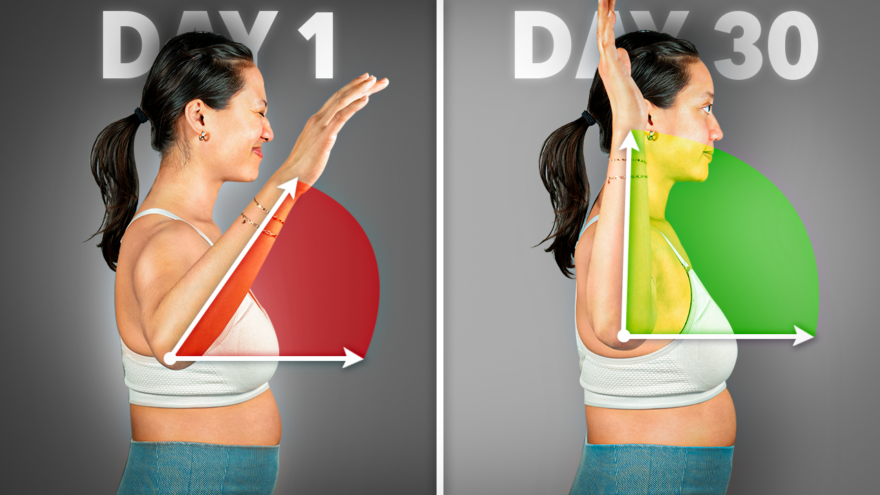Table of Contents
Assessment and Treatment for Shoulder Problems
Improving shoulder mobility can dramatically enhance your overall movement and well-being. In my 13 years as a physical therapist, I’ve pinpointed the most effective exercises to significantly boost shoulder mobility.
Why Shoulder Mobility Matters
Shoulder mobility affects everything from how well you lift objects to how you perform exercises. The key is to find exercises tailored to your unique needs since what works for one person may not work for another. This guide will help you identify your specific mobility needs and offer a progressive exercise plan to enhance your shoulder movement.
Testing Your Shoulder Mobility
To start, assess your shoulder mobility using these three key tests:
- Shoulder External Rotation Test:
- Purpose: Evaluates the movement of your upper back and lower ribs.
- Goal: Achieve 90º movement.
- Self-Test: Stand and reach 1-2 fists from the ground without rotating your pelvis. This will show how well your upper back and ribs move.
- Shoulder Internal Rotation Test:
- Purpose: Assesses the movement of your lower back and upper front ribs.
- Goal: Touch top and bottom of opposite shoulder blade
- Self-Test: Perform Apley’s scratch by reaching your bottom shoulder blade and top tip without arching your back. This helps gauge the movement of your lower back and ribs.
- Shoulder Flexion Test:
- Purpose: Tests rotational movements of your shoulder.
- Goal: Align your arm with your ear.
- Self-Test: Lift your arm to shoulder height. If you cannot lift your arm without arching your back, you may be limited in internal rotation. If you cannot keep your elbow tucked in, you may have external rotation limitations.
Identifying Mobility Patterns
Many videos target one limitation at a time, which can be useful short-term. However, long-term improvement requires addressing all relevant tests together. By considering multiple data points, you can more precisely choose exercises to enhance your shoulder mobility.
Common Mobility Patterns:
- Hella Stiff: Limited mobility across all tests.
- Arched/Flat Back: Limited shoulder flexion and internal rotation.
- Slouched: Limited shoulder flexion and external rotation.
Asymmetrical: One side has limited external rotation (but full internal rotation), the other has limited internal rotation (but full external rotation). Shoulder flexion is limited on both sides.
Exercise Routines Based on Patterns
For Hella Stiff Shoulders:
- 2 Block Decompression: This exercise relieves stiffness by opening up the front and back of the ribcage.
- Steps:
- Lie on your back with a block under the lower ribcage and pelvis
- Relax and let your arms fall to the sides, opening up the chest.
- Hold this position for 1-2 minutes, focusing on deep breathing.
- Foam Roller Roll: Helps release muscle tightness by learning to move with less tension
- Steps:
- Rest your arm on a foam roller
- Slowly roll back and forth.
- Quietly nasal breathe during
- Perform 2-3 minutes per side
- Sidelying Armbar: Improves shoulder and rib cage mobility improving rotation, especially internal, and overall loading
- Steps:
- Lie on your side with a kettlebell or light weight in one hand.
- Extend your arm straight up, keeping the weight stable.
- Inhale an roll to your back
- Exhale and roll back to the start position.
- Do 3×10 rolls per side
- German Arm Swings: Enhances range of motion and flexibility by promoting dynamic shoulder movement.
- Steps:
- Stand with feet shoulder-width apart.
- Swing your arms forward and backward in a controlled manner.
- Perform 20-30 swings, gradually increasing the range.
For Arched Back:
- Supine Frog with Supinated Reach: Opens up upper pelvis and lower thorax, helping your internal rotation.
- Steps:
- Lie on your back with knees bent.
- Feet together and knees apart
- Reach your arms overhead with palms facing up.
- Do 3-4×60 seconds, quietly nasal breathing in, soft mouth exhales.
- Elevated Quad on Elbows: Opens up the front of the body, improving shoulder and hip mobility.
- Steps:
- Get into a quadruped position with your elbows on an elevated surface.
- Push through the wrist, elbow, and knee so the trunk lifts up (3-4/10 effort)
- Do 3x60s, slowly breathing throughout.
- Sidelying Same Connect Roll: Uses rotation and a yoga block to open up the back of the body.
- Steps:
- Lie on your side with a yoga block between the elbow and knee
- Inhale and roll backward
- Exhale and roll forward
- The yoga block should be still throughout
- Do 2-3×10/side
For Slouched Posture:
- Prone Breathing: Opens up the chest so your IR is MEGA.
- Steps:
- Lie face down with a pad or pillow under the lower ribcage
- Arms are above your head
- Press wrist and elbow down so trunk comes up.
- Keep lower ribs touching the pad
- Slow breaths in this position for 2-3x60s
- Prone to Supine Roll: Improves rotation by opening up the chest
- Steps:
- Lie on your stomach with arms overhead
- Inhale and reach arm upwork, rolling to your back
- Exhale and reach so you roll back to your stomach
- Do 2-3×10 rolls/side.
- Back Bend Breathing: Improves chest and shoulder mobility by bending backward over a ball.
- Steps:
- Lie atop a swiss ball with headtipped back
- Arms on the head with the elbows flared out. Press down
- Slowly breathe in this position for 3x60s
For Asymmetrical Shoulders:
- Sidelying Armbar: Improves shoulder and rib cage mobility improving rotation, especially internal, and overall loading
- Steps:
- Lie on your side with a kettlebell or light weight in one hand.
- Extend your arm straight up, keeping the weight stable.
- Inhale an roll to your back
- Exhale and roll back to the start position.
- Do 3×10 rolls per side
- Supine Cross Connect: Targets external rotation loss on the elbow side by improving shoulder alignment.
- Steps:
- Lie on your back with one arm reaching across the body with the elbow bent. It should be around 60º of shoulder flexion
- Same side leg presses into the wall
- Opposite leg lifts up toward midline
- Hold this position for 3×60 seconds, slowly breathing throughout.
- Retro Crawl: Helps balance mobility issues on both sides by encouraging symmetrical movement.
- Steps:
- Begin in a quadruped position
- Press hand and knees into the ground so the trunk comes up
- Crawl backward. Inhale and lift. Exhale and back to the start
- Do 3×5-10 steps/side
Advanced Moves for Enhanced Mobility
If the basic exercises become too easy or you want to take your mobility to the next level, try these advanced movements:
- Hang Shifts: Improves shoulder and upper body flexibility by increasing the range of motion.
- Steps:
- Hang from a bar with both hands.
- Shift your weight from side to side, feeling the stretch in your shoulders.
- Do 3×30-60 seconds per side
- Shoulder Roll: Enhances overall shoulder mobility by promoting dynamic rotation.
- Steps:
- Roll over the top of the shoulder as you reach the arm underneath and across.
- Do 3×3-5 rolls/side.
- Down Dog Ipsilateral Walk: Increases shoulder stability and range of motion by engaging multiple muscle groups.
- Steps:
- Start in a downward-facing dog position.
- Lift one hand and the opposite foot, taking a small step backward
- Take a full breath in this position before alternating sides.
- Do 3×5-10 steps per side.
Sum up
After two weeks of following these exercises, reassess your shoulder mobility to determine if you need to adjust your routine. Shoulder mobility improvement is a gradual process, and consistency is key.

